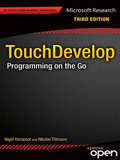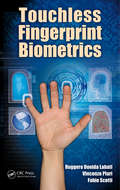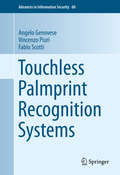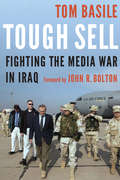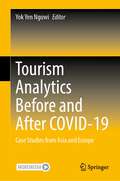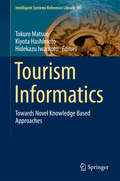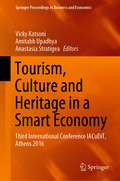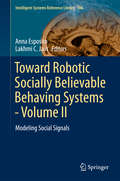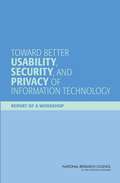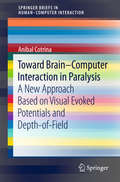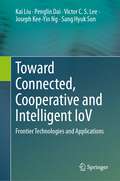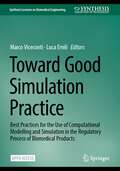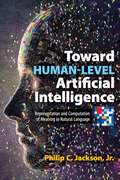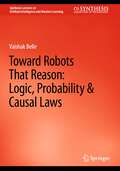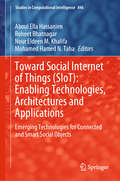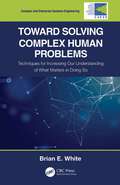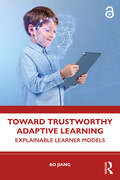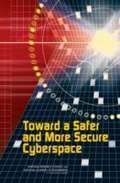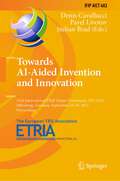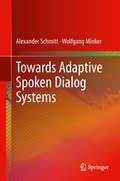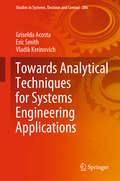- Table View
- List View
Touch-Based Human-Machine Interaction: Principles and Applications
by Arokia Nathan Shuo Gao Shuo Yan Hang ZhaoThis textbook presents a comprehensive treatment of touch technologies, explaining current mainstream and new contact/non-contact based human-machine interactivity (HMI) techniques, which are ubiquitous in modern electronic devices and allow machines to exchange information with users in an efficient and reliable manner. The book provides a detailed study of HMI working principles and practical product examples. Haptic, which has become essential for users to gain immersive experience, is also discussed. The book concludes with an overview of novel applications enabled by emerging technologies, such as advanced materials, virtual reality and machine learning, providing a roadmap for possible development trends for touch interactivities. The book can be used as a graduate text for students in display and touch interface technology courses in electrical and computer engineering, and a professional reference for researchers, practicing engineers, and product designers working in broad areas of engineering. Helps students understand the working principles of current touch technologies;Offers design considerations for prototypes and products;Provides seamless connectivity between broad subject areas involved in HMI, including material science, microelectronic circuits, mechanical engineering, and digital signal processing.
TouchDevelop: Programming on the Go
by R. Nigel Horspool Nikolai Tillmann"The book is great! It''s clear and easy to read, with loads of examples that showed my students what to do. " -- Larry Snyder, Emeritus Professor, University of Washington, Department of Computer Science and Engineering "Having the TouchDevelop book available made our events so much easier. Students could figure things out for themselves with help from the book. " -- Jennifer Marsman, Microsoft Principal Developer Evangelist Mobiledevices such as smartphones and tablets are set to become the main computersthat virtually all people will own and carry with them at all times. And yet,mobile devices are not yet used for all computing tasks. A project at MicrosoftResearch was created to answer a simple question: "It is possible to createinteresting apps directly on a smartphone or tablet, without using a separatePC or a keyboard?" The result is TouchDevelop, a programming environment thatruns on all modern mobile devices such as Windows Phone, iPhone, iPad, Androidphones and tablets, and also on PCs and Macs. This book walks you through all of the screens of the TouchDevelop app, and itpoints out similarities and differences of the TouchDevelop language comparedto other programming languages. For users, the book can serve as a handyreference next to the phone. The book systematically addresses all programminglanguage constructs, starting from the very basic constructs such as variablesand loops. The book also explores many of the phone sensors and data sourceswhich make creating apps for mobile devices so rewarding. If you are new to programming with TouchDevelop, or if you have not yet workedon touchscreen devices, we suggest that you read the book starting from Chapter1. If you are already familiar with the basic paradigm of the TouchDevelopprogramming environment, then feel free to jump ahead to the later chaptersthat address particular topic areas. This book is written from theperspective of a person developing their code using a web browser. TheTouchDevelop Web App runs in many modern browsers on many different devicesincluding smartphones and tablets, Macs, PC. All screenshots and navigationinstructions refer to the TouchDevelop Web App running in a browser. ForWindows Phone, there is a dedicated TouchDevelop app in the Windows Phone Storewhich gives access to many more sensors and data sources. Starting with theTouchDevelop app v3. 0 for Windows Phone 8, the phone app will share the samelook and navigation structure and all features of the Web App. What you''ll learn The little tricks to programming on your mobile devices and for a mobile device The scripting language and cloud-based ecosystem Using cameras, video and audio, and other sensors such as a microphone, accelerometer, compass, and gyroscope Access to the web, authorized access to web services How to write simple games using a built-in physics engine Who this book is for This programming language was written for people who wish tobe able to create apps from their phone. This scenario is particularlyappealing to enthusiastic end-users who own mobile devices and students, whoare the target audience of this book. Table of Contents Chapter 1 Introduction to TouchDevelop Chapter 2 The Scripting Language Chapter 3 The Wall - using the screen Chapter 4 The Web Chapter 5 Audio Chapter 6 Camera, Graphics and Video Chapter 7 Sensors Chapter 8 Interactions Chapter 9 Game Board Chapter 10 UI with Boxes and Pages Chapter 11 Authenticating Web Services Appendix A Editing TouchDevelop Scripts Appendix B TouchDevelop Services Appendix C TouchDevelop Datatypes Appendix D Platform Capabilities Appendix E TouchDevelop Editor on a Windows Phone
Touchless Fingerprint Biometrics (Series in Security, Privacy and Trust)
by Vincenzo Piuri Fabio Scotti Ruggero Donida LabatiThis book offers the first comprehensive analysis of touchless fingerprint-recognition technologies. It gives an overview of the state of the art, describes relevant industrial applications, and presents new techniques to efficiently and effectively implement advanced solutions based on touchless fingerprint biometrics. It considers current problems in developing high-accuracy touchless recognition technology and recommends future work that can be done to address them. A state-of-the-art presentation of the field, it demonstrates that applying touchless technologies to biometric recognition systems shows particular promise.
Touchless Palmprint Recognition Systems
by Vincenzo Piuri Angelo Genovese Fabio ScottiThis book examines the context, motivation and current status of biometric systems based on the palmprint, with a specific focus on touchless and less-constrained systems. It covers new technologies in this rapidly evolving field and is one of the first comprehensive books on palmprint recognition systems. It discusses the research literature and the most relevant industrial applications of palmprint biometrics, including the low-cost solutions based on webcams. The steps of biometric recognition are described in detail, including acquisition setups, algorithms, and evaluation procedures. Constraints and limitations of current palmprint recognition systems are analyzed and discussed. The authors also introduce innovative methods for touchless and less-constrained palmprint recognition, with the aim to make palmprint biometrics easier to use in practical, daily-life applications, and overcome the typical constraints and limitations described. Touchless Palmprint Recognition Systems targets professionals and researchers working in biometrics, image processing and three-dimensional reconstruction. Advanced-level students studying biometrics and computer science will also find this material valuable as a secondary text book or reference.
Tough Sell: Fighting the Media War in Iraq
by John R. Bolton Tom BasileLike the War on Terror, the Media War rages on. More than ever, America’s ability to fight and win against ISIS requires that we understand how best to communicate about war in the digital age. Tom Basile takes readers behind the scenes during his time as a civilian advisor in Iraq during the Iraq War, describing his mission and the struggle to communicate about the war as it became more deadly and less popular at home. The U.S.-led coalition wasn’t merely engaged in a fight to build a more tolerant, participatory society against incredible odds. It was also in a constant clash with forces that influenced public perception about the mission. During those difficult years, it became clear that warfare was now, more than ever, a blend of policy, politics, and the business of journalism. Basile critiques the media’s reporting and assesses the Bush administration’s home-front communications strategy to argue that if policymakers fail to effectively articulate their strategy, manage their message, and counter misinformation, they will find themselves unable to execute that policy. That, Basile argues, places the United States at great risk. Tough Sell blends Basile’s personal story with lessons from the media war in Iraq that can improve our ability to communicate about and prosecute the War on Terror.
Tourism Analytics Before and After COVID-19: Case Studies from Asia and Europe
by Yok Yen NguwiThis book is compilation of different analytics and machine learning techniques focusing on the tourism industry, particularly in measuring the impact of COVID-19 as well as forging a path ahead toward recovery. It includes case studies on COVID-19's effects on tourism in Europe, Hong Kong, China, and Singapore with the objective of looking at the issues through a data analytical lens and uncovering potential solutions. It adopts descriptive analytics, predictive analytics, machine learning predictive models, and some simulation models to provide holistic understanding.There are three ways in which readers will benefit from reading this work. Firstly, readers gain an insightful understanding of how tourism is impacted by different factors, its intermingled relationship with macro and business data, and how different analytics approaches can be used to visualize the issues, scenarios, and resolutions. Secondly, readers learn to pick up data analytics skills from the illustrated examples. Thirdly, readers learn the basics of Python programming to work with the different kinds of datasets that may be applicable to the tourism industry.
Tourism Informatics
by Tokuro Matsuo Kiyota Hashimoto Hidekazu IwamotoThis book introduces new trends of theory and practice of information technologies in tourism. The book does not handle only the fundamental contribution, but also discusses innovative and emerging technologies to promote and develop new generation tourism informatics theory and their applications. Some chapters are concerned with data analysis, web technologies, social media and their case studies. Travel information on the web provided by travelers is very useful for other travelers make their travel plan. A chapter in this book proposes a method for interactive retrieval of information on accommodation facilities to support travelling customers in their travel preparations. Also an adaptive user interface for personalized transportation guidance system is proposed. Another chapter in this book shows a novel support system for the collaborative tourism planning by using the case reports that are collected via Internet. Also, a system for recommending hotels for the users is proposed and evaluated. Other chapters are concerned with recommendation, personalization and other emerging technologies.
Tourism and ICTs: Proceedings of the TURITEC 2023 Conference, October 19–20, 2023, Málaga, Spain (Springer Proceedings in Business and Economics)
by Antonio J. Guevara Plaza Alfonso Cerezo Medina Enrique Navarro JuradoThis open-access book presents the best research papers from the XIV International Congress on Tourism and Information and Communications Technologies (TURITEC2023), held in Málaga, Spain from 19 to 20 October 2023. The book explores the profound impact of COVID-19 on the tourism industry and the increasing importance of digitalization and Information and Communication Technologies (ICTs) as key drivers for the industry's recovery, alongside sustainability. This curated collection of research papers offers conceptualizations, methodologies, analyses, and empirical case studies that illuminate the path to a resilient and sustainable future for tourism.
Tourism, Culture and Heritage in a Smart Economy: Third International Conference IACuDiT, Athens 2016 (Springer Proceedings in Business and Economics)
by Vicky Katsoni Anastasia Stratigea Amitabh UpadhyaThis book explores the ways in which information and communication technologies (ICTs) offer a powerful tool for the development of smart tourism. Numerous examples are presented from across the entire spectrum of cultural and heritage tourism, including art, innovations in museum interpretation and collections management, cross-cultural visions, gastronomy, film tourism, dark tourism, sports tourism, and wine tourism. Emphasis is placed on the importance of the smart destinations concept and a knowledge economy driven by innovation, creativity, and entrepreneurship. New modes of tourism management are described, and tourism products, services, and strategies for the stimulation of economic innovation and promotion of knowledge transfer are outlined. The potential of diverse emerging ICTs in this context is clearly explained, covering location-based services, internet of things, smart cities, mobile services, gamification, digital collections and the virtual visitor, social media, social networking, and augmented reality. The book is edited in collaboration with the International Association of Cultural and Digital Tourism (IACuDiT) and includes the proceedings of the Third International Conference on Cultural and Digital Tourism.
Toward Robotic Socially Believable Behaving Systems - Volume I
by Lakhmi C. Jain Anna EspositoThis volume is a collection of research studies on the modeling of emotions in complex autonomous systems. Several experts in the field are reporting their efforts and reviewing the literature in order to shed lights on how the processes of coding and decoding emotional states took place in humans, which are the physiological, physical, and psychological variables involved, invent new mathematical models and algorithms to describe them, and motivate these investigations in the light of observable societal changes and needs, such as the aging population and the cost of health care services. The consequences are the implementation of emotionally and socially believable machines, acting as helpers into domestic spheres, where emotions drive behaviors and actions. The contents of the book are highly multidisciplinary since the modeling of emotions in robotic socially believable systems requires a holistic perspective on topics coming from different research domains such as computer science, engineering, sociology, psychology, linguistic, and information communication. The book is of interest both to experts and students since last research works on a so complex multidisciplinary topic are described in a neat and didactical scientific language.
Toward Better Usability, Security, and Privacy of Information Technology: Report of a Workshop
by National Research Council of the National AcademiesDespite many advances, security and privacy often remain too complex for individuals or enterprises to manage effectively or to use conveniently. Security is hard for users, administrators, and developers to understand, making it all too easy to use, configure, or operate systems in ways that are inadvertently insecure. Moreover, security and privacy technologies originally were developed in a context in which system administrators had primary responsibility for security and privacy protections and in which the users tended to be sophisticated. Today, the user base is much wider--including the vast majority of employees in many organizations and a large fraction of households--but the basic models for security and privacy are essentially unchanged.Security features can be clumsy and awkward to use and can present significant obstacles to getting work done. As a result, cybersecurity measures are all too often disabled or bypassed by the users they are intended to protect. Similarly, when security gets in the way of functionality, designers and administrators deemphasize it. The result is that end users often engage in actions, knowingly or unknowingly, that compromise the security of computer systems or contribute to the unwanted release of personal or other confidential information. <i>Toward Better Usability, Security, and Privacy of Information Technology</i> discusses computer system security and privacy, their relationship to usability, and research at their intersection.
Toward Brain-Computer Interaction in Paralysis
by Anibal CotrinaThis book presents up-to-date information on Brain-computer Interfaces (BCI). BCIs are systems that record brain signals, extract features and translate them into computer commands. For instance, in BCIs based on the steady-state visual evoked potentials (SSVEP-BCI), brain potentials evoked by visual stimuli are used for controlling computer-based devices. Inspired by the optical phenomenon of depth of field, this book introduces, describes, and evaluates a novel way of setting visual stimuli for SSVEP-BCI. It employs two stimuli that were placed at different distances from the subjects so that if one stimulus is focused on, the other one is non-focused. This assessment allows SSVEP-BCI users to modulate their brain signals by shifting their focus because focused and non-focused stimuli evoke different brain potentials. It allows people to send two brain commands with high accuracy rate by shifting their focus. Hence, computer interaction systems can be proposed for people with paralysis, such as patients with amyotrophic lateral sclerosis since focusing mechanism does not demand head, neck, or eyeball movements. The matter assessed in this book that includes offline and online experiments, is useful for researchers in human-machine interaction who are looking for relevant possibilities of improving the quality of life of people in paralysis situation.
Toward Connected, Cooperative and Intelligent IoV: Frontier Technologies and Applications
by Kai Liu Penglin Dai Victor C.S. Lee Joseph Kee-Yin Ng Sang Hyuk SonThis book offers a comprehensive introduction to technological advances in Internet of Vehicles (IoV), including vehicular communications, vehicular system architectures, data dissemination algorithms, resource allocation schemes, and AI-enabled applications. It focuses on the state-of-the-art IoV with regard to three major directions, namely networking, cooperation, and intelligence, including advanced wireless communication technologies, algorithm theory, optimization mechanisms, and AI technologies. In addition, the book includes a number of case studies with system prototype implementation and hands-on experiments in IoV, making it suitable both as a technical reference work for professionals and as a textbook for graduate students.
Toward Good Simulation Practice: Best Practices for the Use of Computational Modelling and Simulation in the Regulatory Process of Biomedical Products (Synthesis Lectures on Biomedical Engineering)
by Marco Viceconti Luca EmiliThis open access book, the Community of Practice led by the VPH Institute, the Avicenna Alliance, and the In Silico World consortium has brought together 138 experts in In Silico Trials working in academia, the medical industry, regulatory bodies, hospitals, and consulting firms. Through a consensus process, these experts produced the first attempt to define some Good Simulation Practices on how to develop, evaluate, and use In Silico Trials. Good Simulation Practice constitutes an indispensable guide for anyone who is planning to engage at any title with In Silico Trials.
Toward Human-Level Artificial Intelligence: How Neuroscience Can Inform the Pursuit of Artificial General Intelligence or General AI
by Eitan Michael AzoffIs a computer simulation of a brain sufficient to make it intelligent? Do you need consciousness to have intelligence? Do you need to be alive to have consciousness? This book has a dual purpose. First, it provides a multi-disciplinary research survey across all branches of neuroscience and AI research that relate to this book’s mission of bringing AI research closer to building a human-level AI (HLAI) system. It provides an encapsulation of key ideas and concepts, and provides all the references for the reader to delve deeper; much of the survey coverage is of recent pioneering research. Second, the final part of this book brings together key concepts from the survey and makes suggestions for building HLAI. This book provides accessible explanations of numerous key concepts from neuroscience and artificial intelligence research, including: The focus on visual processing and thinking and the possible role of brain lateralization toward visual thinking and intelligence. Diffuse decision making by ensembles of neurons. The inside-out model to give HLAI an inner "life" and the possible role for cognitive architecture implementing the scientific method through the plan-do-check-act cycle within that model (learning to learn). A neuromodulation feature such as a machine equivalent of dopamine that reinforces learning. The embodied HLAI machine, a neurorobot, that interacts with the physical world as it learns. This book concludes by explaining the hypothesis that computer simulation is sufficient to take AI research further toward HLAI and that the scientific method is our means to enable that progress. This book will be of great interest to a broad audience, particularly neuroscientists and AI researchers, investors in AI projects, and lay readers looking for an accessible introduction to the intersection of neuroscience and artificial intelligence.
Toward Human-Level Artificial Intelligence: Representation and Computation of Meaning in Natural Language (Dover Books on Mathematics)
by Philip C. JacksonHow can human-level artificial intelligence be achieved? What are the potential consequences? This book describes a research approach toward achieving human-level AI, combining a doctoral thesis and research papers by the author.The research approach, called TalaMind, involves developing an AI system that uses a 'natural language of thought' based on the unconstrained syntax of a language such as English; designing the system as a collection of concepts that can create and modify concepts to behave intelligently in an environment; and using methods from cognitive linguistics for multiple levels of mental representation. Proposing a design-inspection alternative to the Turing Test, these pages discuss 'higher-level mentalities' of human intelligence, which include natural language understanding, higher-level forms of learning and reasoning, imagination, and consciousness. Dr. Jackson gives a comprehensive review of other research, addresses theoretical objections to the proposed approach and to achieving human-level AI in principle, and describes a prototype system that illustrates the potential of the approach.This book discusses economic risks and benefits of AI, considers how to ensure that human-level AI and superintelligence will be beneficial for humanity, and gives reasons why human-level AI may be necessary for humanity's survival and prosperity.
Toward Robots That Reason: Logic, Probability & Causal Laws (Synthesis Lectures on Artificial Intelligence and Machine Learning)
by Vaishak BelleThis book discusses the two fundamental elements that underline the science and design of artificial intelligence (AI) systems: the learning and acquisition of knowledge from observational data, and the reasoning of that knowledge together with whatever information is available about the application at hand. It then presents a mathematical treatment of the core issues that arise when unifying first-order logic and probability, especially in the presence of dynamics, including physical actions, sensing actions and their effects. A model for expressing causal laws describing dynamics is also considered, along with computational ideas for reasoning with such laws over probabilistic logical knowledge.
Toward Social Internet of Things: Emerging Technologies for Connected and Smart Social Objects (Studies in Computational Intelligence #846)
by Aboul Ella Hassanien Roheet Bhatnagar Nour Eldeen M. Khalifa Mohamed Hamed N. TahaThis unique book discusses a selection of highly relevant topics in the Social Internet of Things (SIoT), including blockchain, fog computing and data fusion. It also presents numerous SIoT-related applications in fields such as agriculture, health care, education and security, allowing researchers and industry practitioners to gain a better understanding of the Social Internet of Things
Toward Solving Complex Human Problems: Techniques for Increasing Our Understanding of What Matters in Doing So (Complex and Enterprise Systems Engineering)
by Brian E. WhiteThis book serves three basic purposes: (1) a tutorial-type reference for complex systems engineering (CSE) concepts and associated terminology, (2) a recommendation of a proposed methodology showing how the evolving practice of CSE can lead to a more unified theory, and (3) a complex systems (CSs) initiative for organizations to invest some of their resources toward helping to make the world a better place.A wide variety of technical practitioners—e.g., developers of new or improved systems (particularly systems engineers), program and project managers, associated staff/workers, funders and overseers, government executives, military officers, systems acquisition personnel, contract specialists, owners of large and small businesses, professional society members, and CS researchers—may be interested in further exploring these topics.Readers will learn more about CS characteristics and behaviors and CSE principles and will therefore be able to focus on techniques that will better serve them in their everyday work environments in dealing with complexity. The fundamental observation is that many systems inherently involve a deeper complexity because stakeholders are engaged in the enterprise. This means that such CSs are more difficult to invent, create, or improve upon because no one can be in total control since people cannot be completely controlled. Therefore, one needs to concentrate on trying to influence progress, then wait a suitable amount of time to see what happens, iterating as necessary. With just three chapters in this book, it seems to make sense to provide a tutorial introduction that readers can peruse only as necessary, considering their background and understanding, then a chapter laying out the suggested artifacts and methodology, followed by a chapter emphasizing worthwhile areas of application.
Toward Trustworthy Adaptive Learning: Explainable Learner Models (Assessment of Educational Technology)
by Bo JiangThis book offers an in-depth exploration of explainable learner models, presenting theoretical foundations and practical applications in the context of educational AI. It aims to provide readers with a comprehensive understanding of how these models can enhance adaptive learning systems.Chapters cover a wide range of topics, including the development and optimization of explainable learner models, the integration of these models into adaptive learning systems, and their implications for educational equity. It also discusses the latest advancements in AI explainability techniques, such as pre-hoc and post-hoc explainability, and their application in intelligent tutoring systems. Lastly, the book provides practical examples and case studies to illustrate how explainable learner models can be implemented in real-world educational settings.This book is an essential resource for researchers, educators, and practitioners interested in the intersection of AI and education. It offers valuable insights for those looking to integrate explainable AI into their educational practices, as well as for policymakers focused on promoting equitable and transparent learning environments.
Toward a Conceptual Network for the Private Law of Artificial Intelligence (Law, Governance and Technology Series #51)
by Paweł Księżak Sylwia WojtczakThis book provides a set of proposals for the new conceptual network required in order to establish civil law rules for a world permeated by Artificial Intelligence. These proposals are intended by their authors to push the debate on the new civil law forward. In spite of the natural conservatism of jurists, some innovative or even futuristic ideas are called for, also because the future, even this not-so-distant one, is difficult to foresee. Paradoxically, and unlike in the past, this lack of knowledge must not stop us from planning. If it does, humankind may, as some pessimists already claim, lose its chance to win the battle for control of the world.The rise and expansion of Artificial Intelligence and robotics in recent years has highlighted a pressing need to create a suitable legal framework for this new phenomenon. The debate on the subject, although wide-ranging and involving many new legal documents, is still quite general and preliminary in nature, although these preparatory works illustrate the very real need to develop appropriate new civil law arrangements. It is exactly the branch of private law where the necessity of these new rules appears to be the most imperative. Autonomous vehicles, medical robots, and expertise software raise fundamental questions on aspects of civil liability such as culpability; whereas the growth in popularity of automated, intelligent software systems for concluding contracts requires a new approach to many fundamental and deeply rooted elements of contract law, e.g. consciousness, intent, error, deception, interpretation of contracts and good faith. Ruling on these specific matters demands the identification and clarification of certain key points, which shall become the foundation for constructing AI/robot civil law.
Toward a Safer and More Secure Cyberspace
by National Research Council National Academy of Engineering of the National AcademiesGiven the growing importance of cyberspace to nearly all aspects of national life, a secure cyberspace is vitally important to the nation, but cyberspace is far from secure today. The United States faces the real risk that adversaries will exploit vulnerabilities in the nation’s critical information systems, thereby causing considerable suffering and damage. Online e-commerce business, government agency files, and identity records are all potential security targets. Toward a Safer and More Secure Cyberspace examines these Internet security vulnerabilities and offers a strategy for future research aimed at countering cyber attacks. It also explores the nature of online threats and some of the reasons why past research for improving cybersecurity has had less impact than anticipated, and considers the human resource base needed to advance the cybersecurity research agenda. This book will be an invaluable resource for Internet security professionals, information technologists, policy makers, data stewards, e-commerce providers, consumer protection advocates, and others interested in digital security and safety.
Towards AI-Aided Invention and Innovation: 23rd International TRIZ Future Conference, TFC 2023, Offenburg, Germany, September 12–14, 2023, Proceedings (IFIP Advances in Information and Communication Technology #682)
by Denis Cavallucci Stelian Brad Pavel LivotovThis book constitutes the proceedings of the 23rd International TRIZ Future Conference on Towards AI-Aided Invention and Innovation, TFC 2023, which was held in Offenburg, Germany, during September 12–14, 2023. The event was sponsored by IFIP WG 5.4.The 43 full papers presented in this book were carefully reviewed and selected from 80 submissions. The papers are divided into the following topical sections: AI and TRIZ; sustainable development; general vision of TRIZ; TRIZ impact in society; and TRIZ case studies.
Towards Adaptive Spoken Dialog Systems
by Alexander Schmitt Wolfgang MinkerIn Monitoring Adaptive Spoken Dialog Systems, authors Alexander Schmitt and Wolfgang Minker investigate statistical approaches that allow for recognition of negative dialog patterns in Spoken Dialog Systems (SDS). The presented stochastic methods allow a flexible, portable and accurate use. Beginning with the foundations of machine learning and pattern recognition, this monograph examines how frequently users show negative emotions in spoken dialog systems and develop novel approaches to speech-based emotion recognition using hybrid approach to model emotions. The authors make use of statistical methods based on acoustic, linguistic and contextual features to examine the relationship between the interaction flow and the occurrence of emotions using non-acted recordings several thousand real users from commercial and non-commercial SDS. Additionally, the authors present novel statistical methods that spot problems within a dialog based on interaction patterns. The approaches enable future SDS to offer more natural and robust interactions. This work provides insights, lessons and inspiration for future research and development, not only for spoken dialog systems, but for data-driven approaches to human-machine interaction in general.
Towards Analytical Techniques for Systems Engineering Applications (Studies in Systems, Decision and Control #286)
by Eric Smith Vladik Kreinovich Griselda AcostaThis book is intended for specialists in systems engineering interested in new, general techniques and for students and practitioners interested in using these techniques for solving specific practical problems. For many real-world, complex systems, it is possible to create easy-to-compute explicit analytical models instead of time-consuming computer simulations. Usually, however, analytical models are designed on a case-by-case basis, and there is a scarcity of general techniques for designing such easy-to-compute models. This book fills this gap by providing general recommendations for using analytical techniques in all stages of system design, implementation, testing, and monitoring. It also illustrates these recommendations using applications in various domains, such as more traditional engineering systems, biological systems (e.g., systems for cattle management), and medical and social-related systems (e.g., recommender systems).

